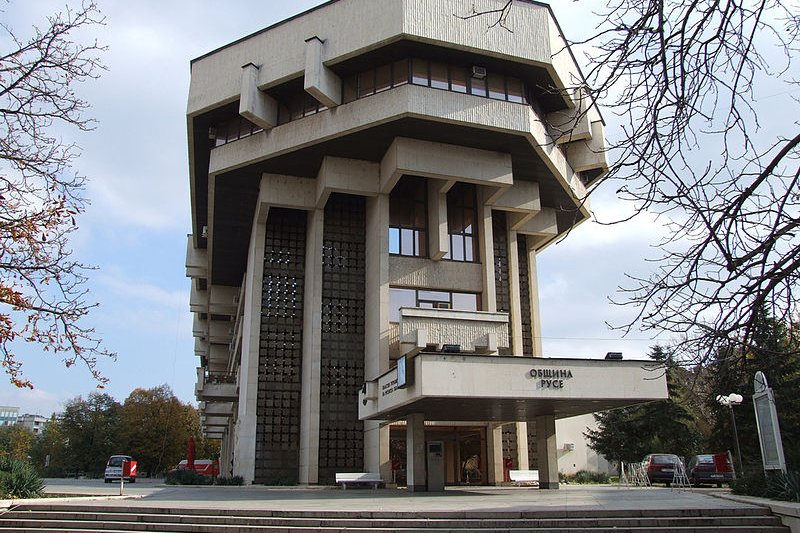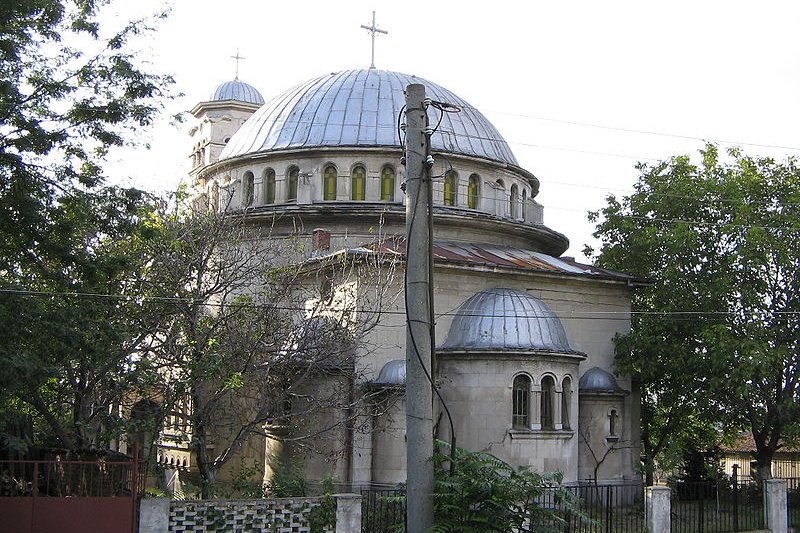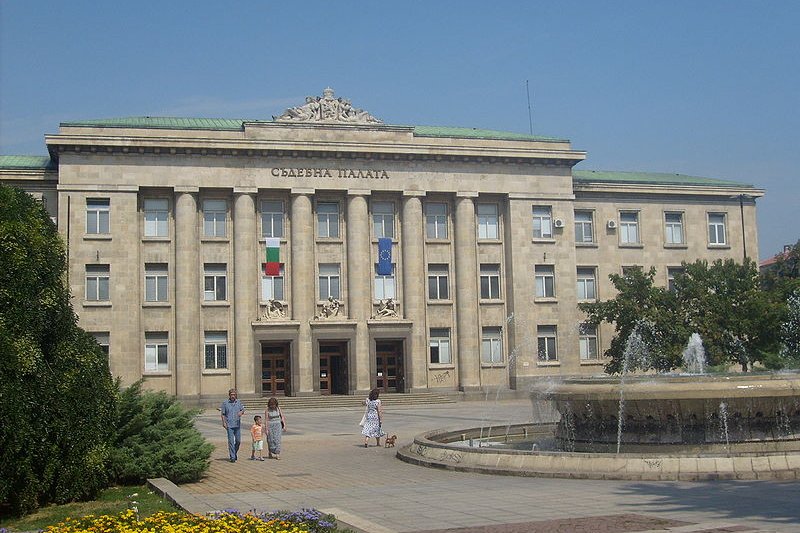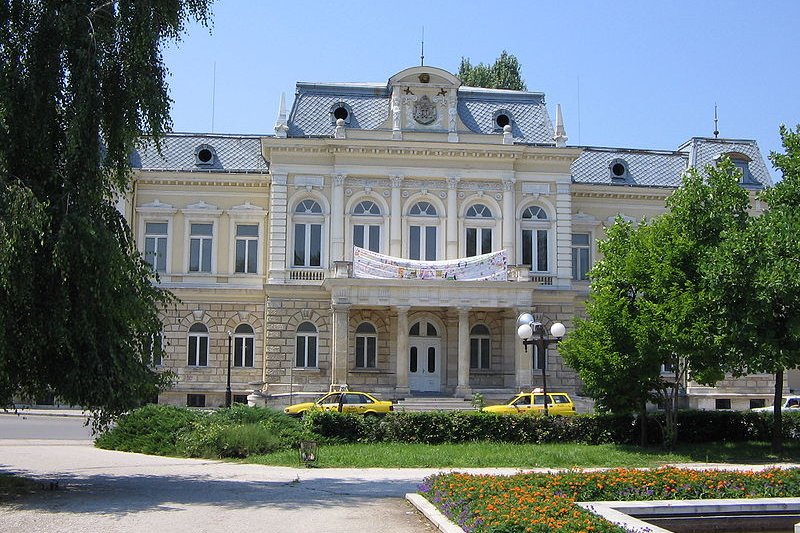 Rousse Municipality Building
Rousse Municipality BuildingSource: https://commons.wikimedia.org/wiki/File:Rousse_municipality.jpg
Author: David

Rousse (Bulgarian: Русе) is a city in northern Bulgaria, on the southern bank of the River Danube, which forms the border, with the city of Giurgau in Romania on the northern side. Also written as Ruse and Russe, it has a population of 150,000 people (2011 estimate) and is the provincial capital of Rousse Province.
Rousse experiences a humid continental climate with hot summers and cold, snowy winters. July is the hottest and wettest month of the year, with an average high temperature of 32°C (90°F) and an average rainfall of 68.8 mm (2.7 in). January is the coldest month with average low temperature of -6°C (21°F).
Rousse has been settled as early as the Neolithic age. During Roman times, Emperor Vespasian had a series of fortifications built here. The fortification was later rebuilt under Emperor Diocletian, but was eventually destroyed by the Goths in AD 250.
 Church of Sveta Petka, Rousse
Church of Sveta Petka, RousseSource: https://commons.wikimedia.org/wiki/File:Rousse-church-St-Petka.jpg
Author: Ivelin Mincov

Rousse first got its present name when it became a fortified settlement under the Second Bulgarian Empire, in the 14th century. The city was conquered by the Ottomans in 1388, and apart from a brief period of unsuccessful liberation attempt, remained under Ottoman rule right until 1878, when Bulgaria became liberated. It was in the years leading towards liberation that Rousse was governed by the Ottoman administrator Midhat Pasha, who was instrumental in transforming the city from an Ottoman garrison town into a modern European city.
Rousse was the second largest city in Bulgaria after Plovdiv until the First World War, when Sofia and Varna began to grow in size and surpassed Rousse and Plovdiv. By the 1980s, Rousse was suffering from both population decrease as well as heightened pollution. Immediately following the fall of Communism and the change to democracy was a difficult period of economic decline and unemployment, which were reversed only in the new millennium, which also brought more environment-friendly industries.
 Palace of Justice, Rousse
Palace of Justice, RousseSource: https://commons.wikimedia.org/wiki/File:Ruse_TodorBozhinov_09.08.09_%2824%29.JPG
Author: Todor Bozhinov

Today Rousse is one of the industrial hubs of Bulgaria. Among the industries in the area include automotive, ceramic, textiles and food processing. There is also a shipyard on the Danube.
Visiting Rousse
Located 300 km from Sofia and 200 km from Varna, Rousse can be reached by train from both these cities, as well as from Bucharest, Athens, Budapest, Istanbul, Kiev and Moscow. There are also bus services linking Rousse with most major cities in Bulgaria, as well as with Greece. Regional History Museum, Rousse
Regional History Museum, RousseSource: https://commons.wikimedia.org/wiki/File:Battenberg_Palace_in_Rousse.jpg
Author: Ivelin Mincov

Places of Interest in Rousse
- Church of Sveta Troitsa
Church blending Baroque and Moscovite styles of architecture built in 1764 when the Ottomans ruled Rousse. - Kaliopa House
19th century villa which was the former residence of Maria "Kaliopa" Kalitsch, wife of the Prussian consul. The villa offers a glimpse into the lifestyle of the well-to-do of Rousse before the First World War. - Pantheon of National Revival Heroes
A golden-dome concrete monument in the Park of the Men of the Revival (Park na Vûzrozhdentsite). An eternal flame burns within it in memory of those who fell in the fight for Bulgarian liberation. - Ploshtad Svoboda (Liberation Square)
Public square at the heart of Rousse, marked by the Liberation Monument at the center, and surrounded by public buildings and sights, including the Drama Theater. - Regional History Museum
Museum occupying the former palace of Prince Aleksandûr Batenberg at Aleksandûr Batenberg Square. The museum exhibits cover periods of Bulgarian history from prehistoric times through Roman and medieval periods. - Sexaginta Prista (Port of Sixty Ships)
This is a port built during the Roman period by Emperor Vespasian. What is visible today are the fortifications and remains of tombstones and inscriptions. - Transport Museum
Museum showcasing various historic vehicles including locomotives and carriages. - Zahari Stoyanov Museum
Museum celebrating the life of revolutionary hero and writer who took part in the April Uprising of 1876 that brought an end to Ottoman rule.
 Latest updates on Penang Travel Tips
Latest updates on Penang Travel Tips
 Discover with Timothy YouTube Channel
Discover with Timothy YouTube Channel
 PG Food Channel
PG Food Channel
 Learn Penang Hokkien YouTube Channel
Learn Penang Hokkien YouTube Channel
 SojiMart Videos
SojiMart Videos
Latest from Discover with Timothy: Gurney Bay - what to see and do there
About this website

Hello and thanks for reading this page. My name is Timothy and my hobby is in describing places so that I can share the information with the general public. My website has become the go to site for a lot of people including students, teachers, journalists, etc. whenever they seek information on places, particularly those in Malaysia and Singapore. I have been doing this since 5 January 2003, for over twenty years already. You can read about me at Discover Timothy. By now I have compiled information on thousands of places, mostly in Peninsular Malaysia and Singapore, and I continue to add more almost every day. My goal is to describe every street in every town in Malaysia and Singapore.
Robbie's Roadmap
- Episode 1: Robbie's Journey to Financial Freedom
- Episode 2: Lost in America
- Episode 3: The Value of Money
- Episode 4: The Mentor
- Episode 5: The Thing that Makes Money
- Episode 6: The walk with a Billionaire
- Episode 7: The Financial Freedom Awakening
- Episode 8: Meet Mr Washington
- Episode 9: The Pizzeria Incident
Copyright © 2003-2024 Timothy Tye. All Rights Reserved.


 Go Back
Go Back